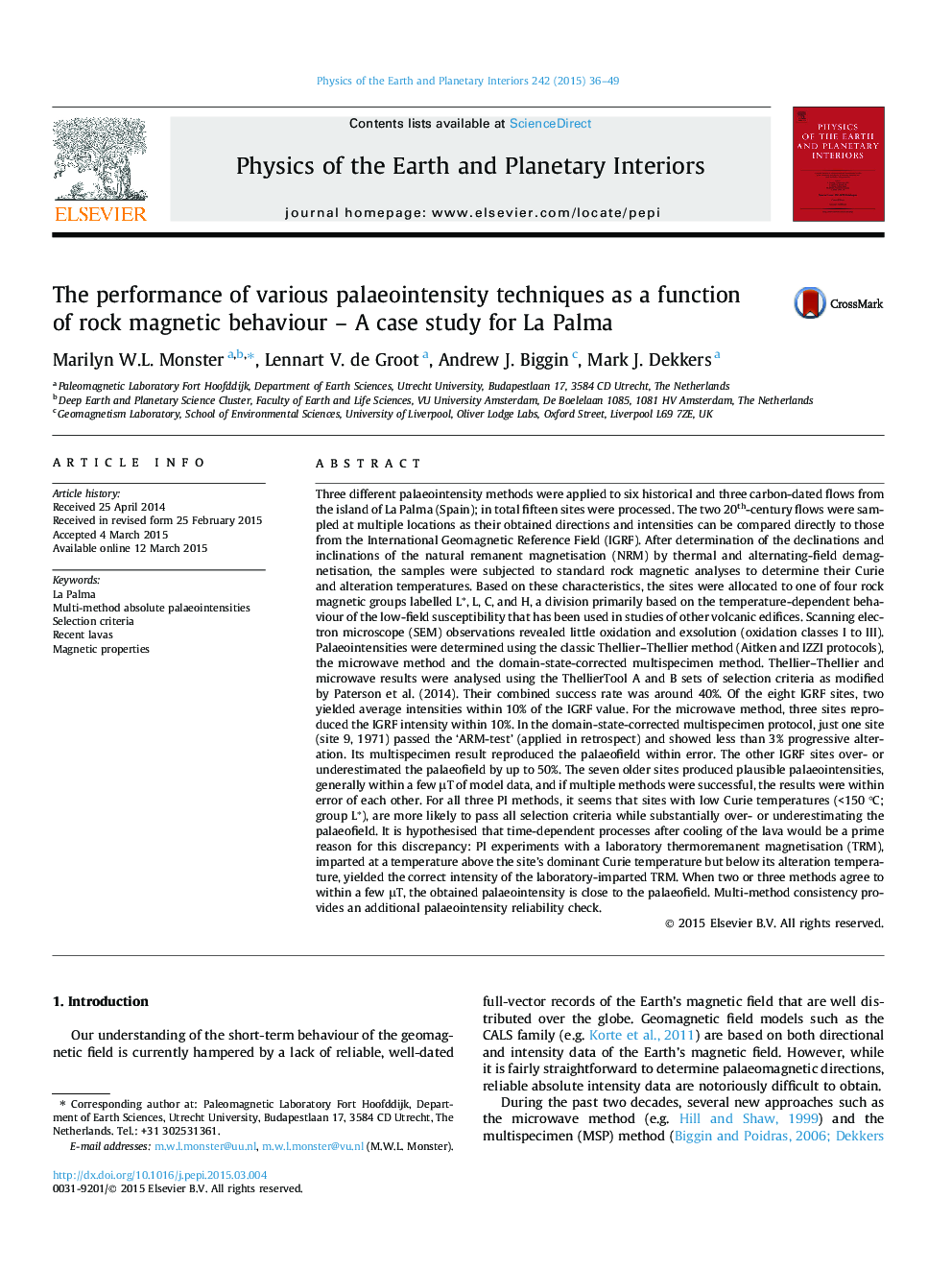| کد مقاله | کد نشریه | سال انتشار | مقاله انگلیسی | نسخه تمام متن |
|---|---|---|---|---|
| 6447504 | 1641499 | 2015 | 14 صفحه PDF | دانلود رایگان |
عنوان انگلیسی مقاله ISI
The performance of various palaeointensity techniques as a function of rock magnetic behaviour - A case study for La Palma
دانلود مقاله + سفارش ترجمه
دانلود مقاله ISI انگلیسی
رایگان برای ایرانیان
کلمات کلیدی
موضوعات مرتبط
مهندسی و علوم پایه
علوم زمین و سیارات
فیزیک زمین (ژئو فیزیک)
پیش نمایش صفحه اول مقاله

چکیده انگلیسی
Three different palaeointensity methods were applied to six historical and three carbon-dated flows from the island of La Palma (Spain); in total fifteen sites were processed. The two 20th-century flows were sampled at multiple locations as their obtained directions and intensities can be compared directly to those from the International Geomagnetic Reference Field (IGRF). After determination of the declinations and inclinations of the natural remanent magnetisation (NRM) by thermal and alternating-field demagnetisation, the samples were subjected to standard rock magnetic analyses to determine their Curie and alteration temperatures. Based on these characteristics, the sites were allocated to one of four rock magnetic groups labelled Lâ, L, C, and H, a division primarily based on the temperature-dependent behaviour of the low-field susceptibility that has been used in studies of other volcanic edifices. Scanning electron microscope (SEM) observations revealed little oxidation and exsolution (oxidation classes I to III). Palaeointensities were determined using the classic Thellier-Thellier method (Aitken and IZZI protocols), the microwave method and the domain-state-corrected multispecimen method. Thellier-Thellier and microwave results were analysed using the ThellierTool A and B sets of selection criteria as modified by Paterson et al. (2014). Their combined success rate was around 40%. Of the eight IGRF sites, two yielded average intensities within 10% of the IGRF value. For the microwave method, three sites reproduced the IGRF intensity within 10%. In the domain-state-corrected multispecimen protocol, just one site (site 9, 1971) passed the 'ARM-test' (applied in retrospect) and showed less than 3% progressive alteration. Its multispecimen result reproduced the palaeofield within error. The other IGRF sites over- or underestimated the palaeofield by up to 50%. The seven older sites produced plausible palaeointensities, generally within a few μT of model data, and if multiple methods were successful, the results were within error of each other. For all three PI methods, it seems that sites with low Curie temperatures (<150 °C; group Lâ), are more likely to pass all selection criteria while substantially over- or underestimating the palaeofield. It is hypothesised that time-dependent processes after cooling of the lava would be a prime reason for this discrepancy: PI experiments with a laboratory thermoremanent magnetisation (TRM), imparted at a temperature above the site's dominant Curie temperature but below its alteration temperature, yielded the correct intensity of the laboratory-imparted TRM. When two or three methods agree to within a few μT, the obtained palaeointensity is close to the palaeofield. Multi-method consistency provides an additional palaeointensity reliability check.
ناشر
Database: Elsevier - ScienceDirect (ساینس دایرکت)
Journal: Physics of the Earth and Planetary Interiors - Volume 242, May 2015, Pages 36-49
Journal: Physics of the Earth and Planetary Interiors - Volume 242, May 2015, Pages 36-49
نویسندگان
Marilyn W.L. Monster, Lennart V. de Groot, Andrew J. Biggin, Mark J. Dekkers,